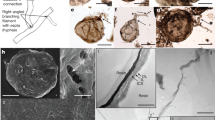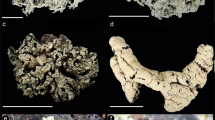Abstract
About one-fifth of all known extant fungal species form obligate symbiotic associations with green algae, cyanobacteria or with both photobionts. These symbioses, known as lichens, are one way for fungi to meet their requirement for carbohydrates1,2. Lichens are widely believed to have arisen independently on several occasions, accounting for the high diversity and mixed occurrence of lichenized and non-lichenized (42 and 58%, respectively) fungal species within the Ascomycota3,4. Depending on the taxonomic classification chosen2,5,6, 15–18 orders of the Ascomycota include lichen-forming taxa, and 8–11 of these orders (representing about 60% of the Ascomycota species) contain both lichenized and non-lichenized species. Here we report a phylogenetic comparative analysis of the Ascomycota, a phylum that includes greater than 98% of known lichenized fungal species5. Using a Bayesian phylogenetic tree sampling methodology7,8 combined with a statistical model of trait evolution9, we take into account uncertainty about the phylogenetic tree and ancestral state reconstructions. Our results show that lichens evolved earlier than believed, and that gains of lichenization have been infrequent during Ascomycota evolution, but have been followed by multiple independent losses of the lichen symbiosis. As a consequence, major Ascomycota lineages of exclusively non-lichen-forming species are derived from lichen-forming ancestors. These species include taxa with important benefits and detriments to humans, such as Penicillium and Aspergillus10,11,12.
This is a preview of subscription content, access via your institution
Access options
Subscribe to this journal
Receive 51 print issues and online access
$199.00 per year
only $3.90 per issue
Buy this article
- Purchase on Springer Link
- Instant access to full article PDF
Prices may be subject to local taxes which are calculated during checkout


Similar content being viewed by others
References
Hawksworth, D. L. The fungal dimension of biodiversity: magnitude, significance, and conservation. Mycol. Res. 95, 641–655 (1991).
Hawksworth, D. L., Kirk, P. M., Sutton, B. C. & Pegler, D. N. Dictionary of the Fungi (CAB, Wallingford, 1995).
Barinaga, M. Origins of lichen fungi explored. Science 268, 1437 (1995).
Gargas, A., DePriest, P. T., Grube, M. & Tehler, A. Multiple origins of lichen symbioses in fungi suggested by SSU rDNA phylogeny. Science 268, 1492–1495 (1995).
Honegger, R. in Lichen Biology (ed. Nash, T. H.) 24–36 (Cambridge Univ. Press, Cambridge, 1996).
Hafellner, J. in Handbook of Lichenology Vol. 3 (ed. Galun, M.) 41–52 (CRC, Boca Raton, 1988).
Larget, B. & Simon, D. L. Markov chain monte carlo algorithms for the Bayesian analysis of phylogenetic trees. Mol. Biol. Evol. 16, 750–759 (1999).
Huelsenbeck, J. P., Rannala, B. & Masly, J. P. Accomodating phylogenetic uncertainty in evolutionary studies. Science 288, 2349–2350 (2000).
Pagel, M. The maximum likelihood approach to reconstructing ancestral character states of discrete characters on phylogenies. Syst. Biol. 48, 612–622 (1999).
Berbee, M. L., Yoshimura, A., Sugiyama, J. & Taylor, J. W. Is Penicillium monophyletic? An evaluation of phylogeny in the family Trichocomaceae from 18S, 5.8S, and ITS ribosomal DNA sequence data. Mycologia 87, 210–222 (1995).
Alexopoulos, C. J., Mims, C. W. & Blackwell, M. Introductory Mycology (John Wiley & Sons, New York, 1996).
Suh, S.-O. & Blackwell, M. Molecular phylogeny of the cleistothecial fungi placed in Cephalothecaceae and Pseudeurotiaceae. Mycologia 91, 836–848 (1999).
Berbee, M. L. & Taylor, J. W. From 18S ribosomal sequence data to evolution of morphology among the fungi. Can. J. Bot. (Suppl. 1) 73, S677–S683 (1995).
Spatafora, J. W. Ascomal evolution of filamentous ascomycetes: evidence from molecular data. Can. J. Bot. (Suppl. 1) 73, S811–S815 (1995).
Berbee, M. L., Carmean, D. A. & Winka, K. Ribosomal DNA and resolution of branching order among the Ascomycota: how many nucleotides are enough? Mol. Phyl. Evol. 17, 337–344 (2000).
Bhattacharya, D. et al. Widespread occurrence of spliceosomal introns in the rDNA genes of ascomycetes. Mol. Biol. Evol. 17, 1971–1984 (2000).
Liu, Y. J., Whelen, S. & Hall, B. D. Phylogenetic relationships among ascomycetes: evidence from the RNA polymerase II subunit. Mol. Biol. Evol. 16, 1799–1808 (1999).
Collins, T. M., Wimberger, P. H. & Naylor, G. J. P. Compositional bias, character-state bias, and character-state reconstruction using parsimony. Syst. Biol. 43, 482–496 (1994).
Maddison, D. R. Phylogenetic methods for inferring the evolutionary history and process of change in discretely valued characters. Ann. Rev. Entomol. 39, 267–292 (1994).
Pagel, M. Detecting correlated evolution on phylogenies: a general method for the comparative analysis of discrete characters. Proc. R. Soc. Lond. B 255, 37–45 (1994).
Pagel, M. Inferring the historical patterns of biological evolution. Nature 401, 877–884 (1999).
Elix, J. A. in Lichen Biology (ed. Nash, T. H.) 154–180 (Cambridge Univ. Press, Cambridge, 1996).
Rambold, G. & Triebel, D. The inter-lecanoralean associations. Bibliotheca Lichenologica 48, 1–201 (1992).
Hibbett, D. S., Gilbert, L.-B. & Donoghue, M. J. Evolutionary instability of ectomycorrhizal symbioses in basidiomycetes. Nature 407, 506–508 (2000).
Lutzoni, F. & Vilgalys, R. Omphalina (Basidiomycota, Agaricales) as a model system for the study of coevolution in lichenized fungi. Crypt. Bot. 5, 82–97 (1995).
Lutzoni, F. Phylogeny of lichen- and non lichen-forming omphalinoid mushrooms and the utility of testing for combinability among multiple data sets. Syst. Biol. 46, 373–406 (1997).
Lutzoni, F. & Pagel, M. Accelerated evolution as a consequence of transition to mutualism. Proc. Natl Acad. Sci. USA 94, 11422–11427 (1997).
Kranner, I. & Lutzoni, F. in Plant Responses to Environmental Stresses: From Phytohormones to Genome Reorganization (ed. Lerner, H. R.) 591–628 (Marcel Dekker, New York, 1999).
Wilson, I. & Balding, D. Genealogical inference from microsatellite data. Genetics 150, 499–510 (1998).
Hillis, D. M., Moritz, C. & Mable, B. K. Molecular Systematics 2nd edn (Sinauer, Sunderland, 1996).
Acknowledgements
We thank P. Lewis and K. Pryer for insightful suggestions; J. Spatafora, D. Armaleo, C. and W. Culberson for initiating the first phase of this project; U. Søchting, J. Spatafora, J. Johnson and S. LaGreca for providing unpublished sequences; J. Bélisle for assistance with Figs 1 and 2; J. Crodian for technical assistance; I. Brodo, D. Gernandt, C. Keller, T. Lumbsch, J. Miadlikowska, J. Platt and U. Søchting for providing lichen material or DNA samples; F. Kauff, T. Bjelland, B. Büdel, P. M. Jørgensen and M. Schultz for the identification of some lichen specimens; and M. Blackwell for comments on the manuscript. This work was supported by a grant from the US National Science Foundation to F.L. and the Pritzker Foundation Fund of The Field Museum. M.P. is supported by the Leverhulme Trust and the Biotechnology and Biological Sciences Research Council of the UK.
Author information
Authors and Affiliations
Corresponding author
Supplementary Information
Rights and permissions
About this article
Cite this article
Lutzoni, F., Pagel, M. & Reeb, V. Major fungal lineages are derived from lichen symbiotic ancestors. Nature 411, 937–940 (2001). https://doi.org/10.1038/35082053
Received:
Accepted:
Issue Date:
DOI: https://doi.org/10.1038/35082053
This article is cited by
-
Generation and comprehensive analysis of Synechococcus elongatus–Aspergillus nidulans co-culture system for polyketide production
Biotechnology for Biofuels and Bioproducts (2023)
-
Diversity of hyperparasitic fungi on Meliolales (Sordariomycetes, Ascomycota): new species, records, and molecular data from Benin and Panama
Mycological Progress (2023)
-
Taxonomic monograph of epifoliar fungi
Fungal Diversity (2023)
-
Large differences in carbohydrate degradation and transport potential among lichen fungal symbionts
Nature Communications (2022)
-
A comparative genomic analysis of lichen-forming fungi reveals new insights into fungal lifestyles
Scientific Reports (2022)
Comments
By submitting a comment you agree to abide by our Terms and Community Guidelines. If you find something abusive or that does not comply with our terms or guidelines please flag it as inappropriate.



